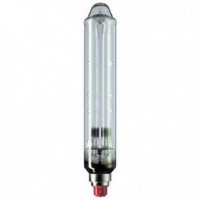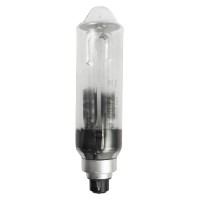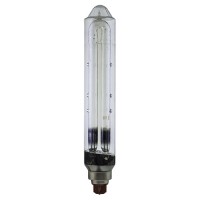Low Pressure Sodium
Low Pressure Sodium (LPS) lamps represent the most efficient light source ever commercially produced, converting electricity to visible light at efficacies approaching 200 lumens per watt – roughly twice the efficiency of high pressure sodium and several times better than metal halide or fluorescent lighting. However, this extraordinary efficiency comes with a significant trade-off: LPS lamps produce monochromatic yellow-orange light with a color rendering index of essentially zero, meaning all colors appear as shades of gray or yellow. This makes LPS suitable only for applications where color rendering is completely unimportant.
The distinctive light from LPS lamps is unmistakable – a pure yellow-orange glow with no color rendering whatsoever. This is because LPS lamps produce light at a single wavelength (589 nanometers) in the yellow portion of the visible spectrum. Everything illuminated by LPS light appears in monochrome – faces look ghoulish, red cars and blue cars look identical, green foliage appears yellowish-gray. For applications requiring any color recognition, LPS is completely unsuitable. For pure navigation and visibility where color doesn't matter, LPS can be remarkably efficient.
Historical applications included street lighting, security perimeter lighting, tunnel lighting, and industrial yard lighting where the priority was maximum visibility per watt and color rendering was irrelevant. Some European cities used extensive LPS street lighting for decades due to the energy savings and the reduced light pollution (the monochromatic yellow light is easier to filter in astronomical observations). However, LPS has been largely replaced by high pressure sodium and increasingly by LED in most applications due to the color rendering disadvantages and maintenance considerations.
The physical characteristics of LPS lamps are distinctive. The lamps are considerably larger than HPS or metal halide lamps of equivalent wattage due to the low-pressure discharge requiring a longer arc tube. A 180W LPS lamp might be 2-3 feet long in a characteristic U-shaped configuration enclosed in an outer envelope. This size requires larger fixtures than other HID technologies, adding to installation costs and making retrofitting existing fixtures challenging.
Operating characteristics include a warm-up period of 10-15 minutes to reach full output, similar to other HID sources, and a restrike time of several minutes if power is interrupted. LPS lamps require specific LPS ballasts – they're not interchangeable with HPS or metal halide ballasts. The rated life of LPS lamps is quite long, typically 18,000-25,000 hours, and they maintain reasonably good lumen maintenance (output stays relatively consistent over life).
The practical reality is that LPS technology has become increasingly rare. Many utilities and municipalities that once used LPS street lighting have converted to HPS or LED due to the color rendering advantages, smaller fixture sizes, and (in the case of LED) even better efficiency with actually usable color rendering. Finding replacement LPS lamps has become progressively more difficult as manufacturers have reduced or ceased production. For facilities with existing LPS installations, the decision point usually comes when lamps or ballasts need replacement – continuing with LPS may no longer be practical or economical.
The environmental considerations include proper disposal (LPS lamps contain sodium metal that reacts with water) and the question of whether the efficiency advantages justify the complete lack of color rendering. Modern LED street lighting can achieve 140-160 lumens per watt with good color rendering, narrowing the efficiency gap to where the color rendering advantages of LED outweigh the modest remaining efficiency advantage of LPS for most applications.
Common Wattages: 18W, 35W, 55W, 90W, 135W, 180W. U-shaped tube configuration in outer envelope. Bayonet cap bases common.
Characteristics: Highest efficacy of any light source (~200 lm/W), monochromatic yellow light (589nm), zero color rendering (CRI 0), long life (18,000-25,000 hours)
Historical Applications: Street lighting, security lighting, tunnel lighting, industrial yards, anywhere maximum efficiency mattered and color rendering was unimportant
Status: Largely obsolete, replaced by HPS and LED. Availability decreasing. Consider LED retrofit for better color rendering with excellent efficiency.
SOX35
Wattage: 35W, Type: Low Pressure Sodium Bulb, Color Temp (Kelvin): 1700K, Lumens: 4550, Lamp Shape..
Contact for Price
SOX18
Wattage: 18W, Type: Low Pressure Sodium Bulb, Color Temp (Kelvin): 1700K, Lumens: 1800, Lamp Shape..
Contact for Price
SOX90
Wattage: 90W, Type: Low Pressure Sodium Bulb, Color Temp (Kelvin): 1800K, Lumens: 13,500, Lamp..
Contact for Price



